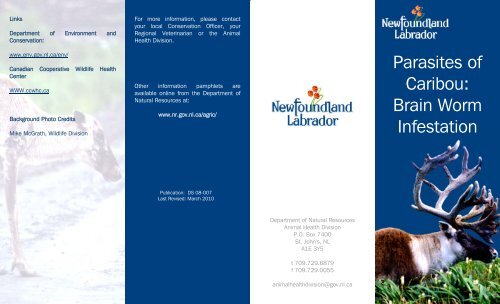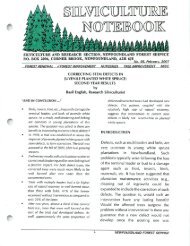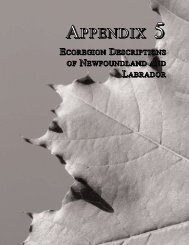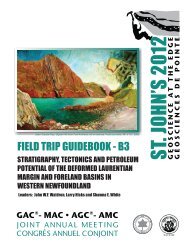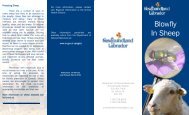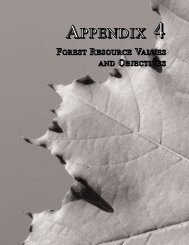Parasites of Caribou: Brain Worm Infestation - Department of Natural ...
Parasites of Caribou: Brain Worm Infestation - Department of Natural ...
Parasites of Caribou: Brain Worm Infestation - Department of Natural ...
You also want an ePaper? Increase the reach of your titles
YUMPU automatically turns print PDFs into web optimized ePapers that Google loves.
Links<br />
<strong>Department</strong> <strong>of</strong> Environment and<br />
Conservation:<br />
www.env.gov.nl.ca/env/<br />
Canadian Cooperative Wildlife Health<br />
Center<br />
WWW.ccwhc.ca<br />
Background Photo Credits<br />
Mike McGrath, Wildlife Division<br />
For more information, please contact<br />
your local Conservation Officer, your<br />
Regional Veterinarian or the Animal<br />
Health Division.<br />
Other information pamphlets are<br />
available online from the <strong>Department</strong> <strong>of</strong><br />
<strong>Natural</strong> Resources at:<br />
www.nr.gov.nl.ca/agric/<br />
Publication: DS 08-007<br />
Last Revised: March 2010<br />
<strong>Department</strong> <strong>of</strong> <strong>Natural</strong> Resources<br />
Animal Health Division<br />
P.O. Box 7400<br />
St. John's, NL<br />
A1E 3Y5<br />
t 709.729.6879<br />
f 709.729.0055<br />
animalhealthdivision@gov.nl.ca<br />
<strong>Parasites</strong> <strong>of</strong><br />
<strong>Caribou</strong>:<br />
<strong>Brain</strong> <strong>Worm</strong><br />
<strong>Infestation</strong>
Introduction<br />
<strong>Brain</strong> worm is the common name<br />
for a disease <strong>of</strong> caribou that was first<br />
recognized in Central Newfoundland in<br />
the 1970's; and it has since been seen<br />
in other caribou herds, including most<br />
recently the caribou <strong>of</strong> the Southern<br />
Avalon. Its more scientific name is<br />
Cerebrospinal Elaphostrongylosis (CSE)<br />
and is caused by the nematode<br />
Elaphostrongylus rangiferi. Infection can<br />
cause severe illness and death in<br />
affected animals, and it has a particularly<br />
strong impact on herds that have not<br />
been previously exposed to this parasite.<br />
As this is primarily a disease <strong>of</strong><br />
caribou, there is no direct public health<br />
threat to humans. Moose can carry the<br />
worm and will sometimes develop signs<br />
<strong>of</strong> illness. In Scandinavia, there are<br />
reports that sheep and goats that graze<br />
on contaminated pasture can become<br />
sick. There are, however, no such reports<br />
in Newfoundland from areas where both<br />
sheep and caribou graze.<br />
History<br />
In 1908, 300 reindeer were<br />
introduced into Newfoundland from<br />
Norway. This was done in order to supply<br />
Newfoundlander’s with a readily available<br />
food supply, as the native caribou herds<br />
were diminished due to hunting. The<br />
reindeer landed in St. Anthony and were<br />
herded to various parts <strong>of</strong> the island. It is<br />
believed that these reindeer (which are<br />
very closely related to the caribou)<br />
brought this worm into the province.<br />
Life Cycle<br />
This worm goes through different stages <strong>of</strong> development from an egg to a number <strong>of</strong><br />
larval (immature) stages, until it finally becomes the adult worm. To complete this life cycle,<br />
the worm must live in two different hosts. The final host is the animal that contains the<br />
adult worm or egg-laying part <strong>of</strong> the worm’s life cycle. The intermediate host is the animal<br />
that contains one or more <strong>of</strong> the larval stages <strong>of</strong> the worm. For brain worm, the caribou is<br />
the final host, and the intermediate hosts are snails and slugs.<br />
Snails and slugs crawl over the fecal pellets <strong>of</strong> infected caribou. The fecal pellets<br />
contain the larvae <strong>of</strong> this worm, which penetrates into the snail or slug. When the caribou is<br />
eating vegetation, it accidentally eats the snails or slugs that are on the vegetation. The<br />
larvae then penetrate the caribou’s stomach wall and go into the spinal cord where they can<br />
travel to the brain. Once in the brain, they develop into young adults and go back down the<br />
spinal cord to the legs. The worm reaches maturity in the large flat muscles around the<br />
shoulder blades and the hindquarters. The female worms penetrate blood vessels and lay<br />
eggs. These eggs go to the lungs and develop into larvae, which then travel up the windpipe<br />
(trachea) and get swallowed. Once swallowed, the larvae now get excreted with the fecal<br />
pellets.<br />
Figure 1: Life Cycle <strong>of</strong> the <strong>Brain</strong> <strong>Worm</strong><br />
Signs in Sick <strong>Caribou</strong><br />
A severely infected caribou.<br />
<strong>Caribou</strong> infected with this worm<br />
show several behaviour changes, including<br />
isolating themselves from the herd, staying<br />
in one location, losing their fear <strong>of</strong><br />
humans, seeming disoriented and<br />
developing an abnormal posture and gait.<br />
Sick animals may even be seen walking in<br />
a continuous circle. They may also<br />
become thin even though they continue to<br />
eat.<br />
If you should see a caribou<br />
displaying these signs, you should not<br />
hunt it but inform a Conservation Officer <strong>of</strong><br />
the animal’s location.


